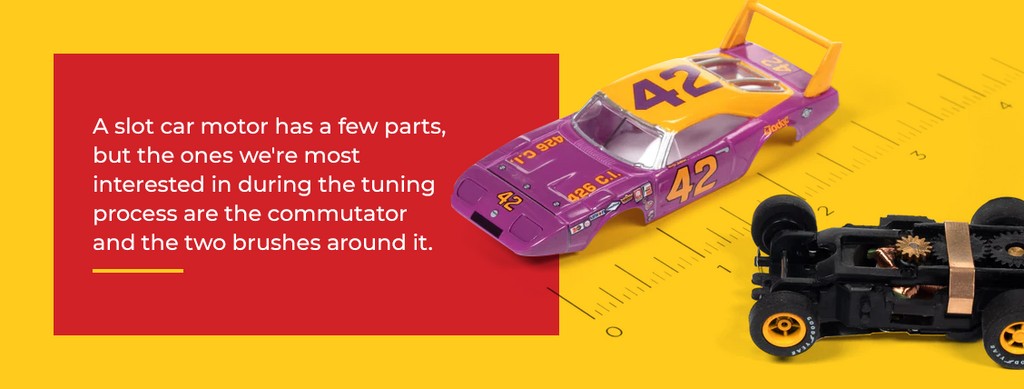For slot car racing enthusiasts, speed and smooth performance are paramount. This comprehensive guide delves into the intricacies of Ho Slot Car Tuning, providing detailed steps to optimize your car’s performance. From tire truing to motor maintenance, these techniques will enhance your slot car’s grip, speed, and overall mechanical prowess.
Initial Inspection and Necessary Tools
Before embarking on the tuning process, gather essential tools like sandpaper (coarse and fine grit), a screwdriver, a nail file, glue, tape, and oil. Begin by detaching the chassis from the body and removing the tires from the rims. This disassembly allows for a thorough inspection of individual components.
Carefully rotate each rim to detect any looseness. If present, apply glue to secure them firmly to the axle. Examine for cracks or defects. Assess the bearings by gently moving the axle vertically and horizontally. Glue can stabilize any loose bearings. This meticulous inspection identifies areas requiring attention.
Tire Truing and Cleaning for Optimal Grip
While seemingly round, new slot car tires often have imperfections that hinder track grip. Tire truing aims to create a flat tire profile, maximizing contact with the track surface.
Truing Techniques for HO Slot Cars
Focus on truing the rear tires. Secure the controller’s trigger using tape or an elastic band to power one lane. Place sandpaper on a flat track section. With the rear tires off the track, gently lower them onto the spinning sandpaper, holding the chassis steady. Avoid excessive pressure to prevent overheating.
Regularly inspect the tire’s surface, continuing until a uniform color indicates a flat profile. Use finer grit sandpaper for a smooth finish. Round off any sharp tire edges with sandpaper to prevent tipping. True plastic rims (if necessary) using the same method, employing a nail file for intricate areas.
After truing, secure the tires to the rims with glue, applying small amounts evenly around the circumference. Clean the tires with a damp cloth to remove debris.
Weight Adjustment for Balanced Performance
Ideally, a slot car performs optimally without added weight. However, observe its track behavior, particularly at high speeds. Tipping, oversteering (rear sliding), and understeering (front wheels leaving the track) indicate the need for weight adjustments.
Add weight centrally and low for tipping issues. Position weight near the rear axle for oversteering and towards the front for understeering. Distribute weight evenly, typically on either side of the motor. Incrementally increase weight, testing after each adjustment until achieving seamless performance.
Smoothing Gear Mesh for Quiet Operation
Noisy gears often signify the need for smoothing. Manually rotate the rear wheels; clicking sounds indicate rough gear mesh. Apply abrasive toothpaste to the gears, running the motor for 5-10 minutes. Clean thoroughly to remove any residue. This process results in smoother, quieter, and faster operation.
Addressing Misshapen Gears
Stiffness during wheel rotation suggests misshapen gears. Identify the stiff point and inspect the gears with a magnifying glass. File or reshape any deformed teeth to match the others. This meticulous approach ensures smooth gear operation.
Body Float Optimization for Enhanced Cornering
Loosen the screws connecting the body and chassis to allow for body float. This reduces stress on the chassis and allows for better weight distribution during cornering, improving grip. Loosen screws gradually, testing after each adjustment.
Consider factors like car type (non-magnetic cars benefit most), center of gravity, and chassis design when adjusting body float. Secure loosened screws with tape or tack to prevent them from falling out.
Motor Performance Enhancement: Running-In and Maintenance
Optimize motor performance by focusing on the commutator and brushes. Use an adjustable power supply to run the motor in the car with the rear wheels lifted. Apply oil to the shaft ends and run the motor at three volts for 30 minutes, then at six volts for another 30 minutes, adding oil as needed.
Alternatively, run the motor underwater in deionized water, following a specific procedure involving isopropyl alcohol and an air duster for cleaning and drying. Both methods enhance motor performance and longevity. This meticulous approach ensures optimal motor performance.
Conclusion: Achieving Peak Performance in HO Slot Car Racing
By implementing these HO slot car tuning techniques, you can significantly improve your car’s performance on the track. Remember to be patient and methodical, testing after each adjustment to ensure optimal results. With careful tuning, your slot car will achieve greater speed, smoother handling, and enhanced overall performance.


